The capital of Saxony was one of the most beautiful cities in Germany. Capital of the former kingdom of Saxony, the city was known as the Florence of the Elbe due to the large number of monumental buildings built during the 18th century. Despite its beauty, the city was completely flattened by a massive British bombardment in the closing stages of World War II, making it one of the most destroyed cities in Nazi Germany. With no military value and no war industry, the city should not have become a target for the British air force. Today there is debate about whether the bombing of Dresden should be considered a war crime by the victors.
Dresden under the swastika
The city of Dresden has always been considered one of the most beautiful in Europe. The city, capital of Saxony and fervently Protestant, was one of the strongholds of Nazi Germany. A place visited by thousands of tourists each year, Dresden went unnoticed by the allies during almost the entire warlike conflict.
By the end of 1944 it was becoming clear throughout Germany that the war was lost. Especially in the easternmost provinces of the country, the ever-closer front line was felt with terror. In the last weeks of 1944 and the first weeks of 1945, thousands of refugees from the east began to invade central Germany. Dresden was one of the central locations for this reception of East Germans. Some will stay, but thousands of them will continue on their way to even more western provinces, fearing the arrival of Soviet troops.
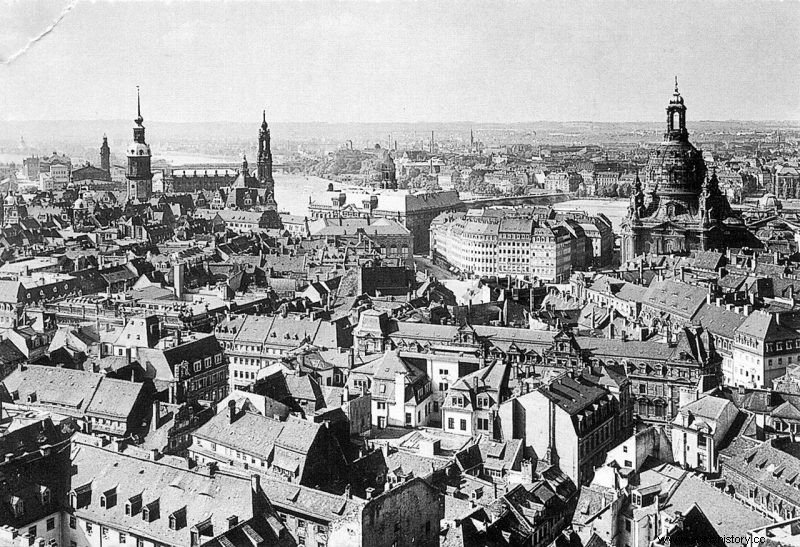
But Dresden is not only a place of passage for thousands of refugees. The city is also a crossing point for thousands of soldiers sent to reinforce the shaky eastern front. There are also many field hospitals in the city, which are overwhelmed. Despite the dire conditions on the eastern front, many still feel safe in Dresden. Until then, Allied bombers had left the city alone in search of other, more important targets.
Dresden under the bombs
In February 1945, representatives of the Big Three met in Yalta, on the shores of the Black Sea:the Soviet Union, the United States, and the United Kingdom. At this conference, the guidelines for the future of Europe began to be set, but specific objectives were also set to speed up the end of the war. One of those goals was the bombing by Britain of eastern German cities. It was thought that these bombings would spread panic among the civilian population and would also cause a mass exodus of refugees, which would block the communication routes of Nazi Germany, thus facilitating the Russian advance to the east. The United States and the Soviet Union agreed with this plan.
Although the German command rules out a massive attack on Dresden, the British soon organize an operation to wipe the city off the map. The bombing of Dresden would take the name of Operation Thunderclap . The mission is planned by the strategic bombing command. The Commander-in-Chief is Arthur Harris, popularly known as the Bomber Harris. Under his command the revolutionary technique of carpet bombing was developed.
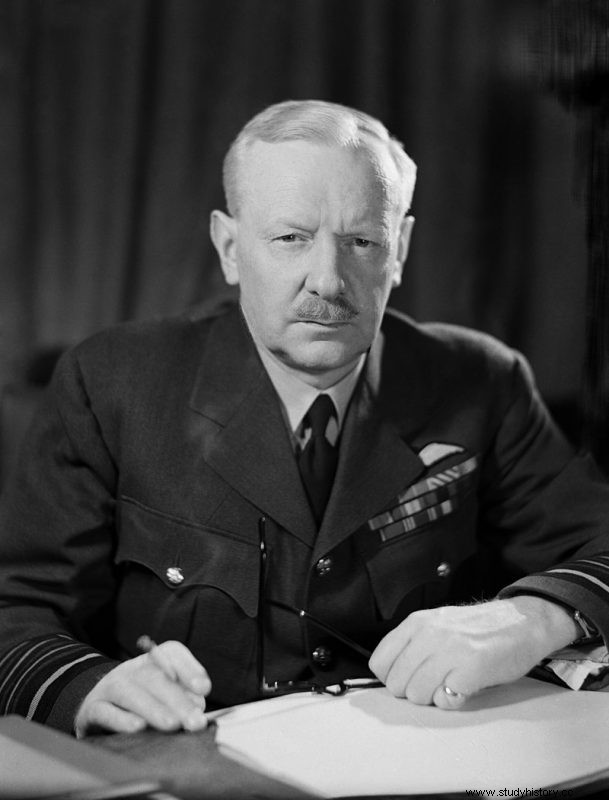
Since 1942, British strategic bomber squadrons have harassed the cities of Nazi Germany using the technique of carpet bombing. The goal is to cause spectacular damage to panic the population and thus lower the morale of the German people. The Nazis had started the war with similar bombing raids on Warsaw, Rotterdam or Coventry. Now they suffered those attacks in their own flesh.
February 13, 1945 was carnival day in Dresden. Carnival is one of the most deeply rooted festivities in Germany since the Middle Ages. Despite the war, in 1945 it was still held in Dresden. The population tried to forget the conflict and the proximity of the Russians. The children were the only ones who didn't realize what was happening and they really enjoyed themselves that day, playing and dancing around the center of Dresden dressed in the most diverse ways.
That same day in Great Britain the first bombardment of Dresden is prepared. The strategic bombing command has given orders to load hundreds of planes with bombs of different types so that they can bomb Dresden at night. The plan was simple:fly 2,700 kilometers from bases in Britain to Dresden, dump the bombs, and return to base.
Around five-thirty in the afternoon the order was given for the planes to take off. The crews faced a five-hour flight over the sea first, and over Nazi Germany later. At 21:40 the air raid alarm sounded. Similar alarms had sounded on other occasions, but they had always been false warnings of an attack, so many people did not take them seriously. Things changed when the first planes approaching the city began to be heard.
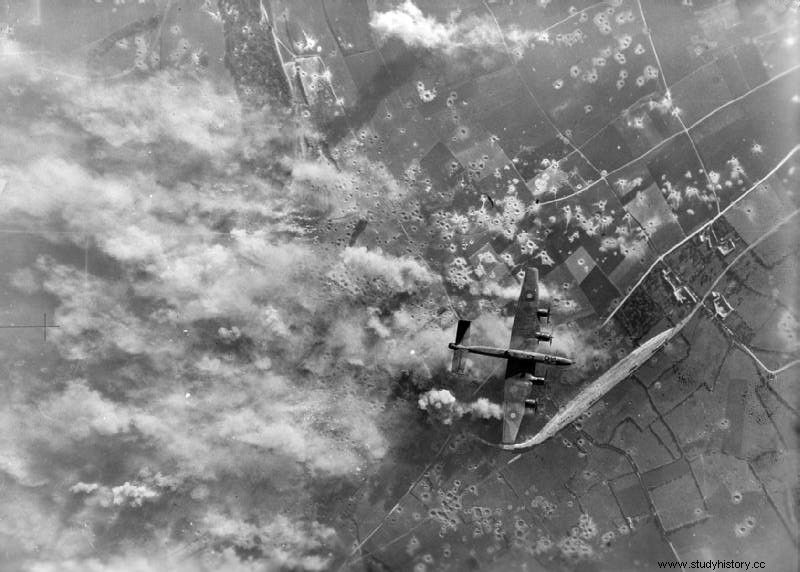
Around 22:30 the bombardments reached the objective. He ordered a massive bombing of the historic center of the city, a space full of significance for Germany and also highly populated. The first step of the bombardment was the illumination of the city. To bomb accurately, the RAF used bombs packed with flares that were dropped on targets. These bombs fell slowly thanks to small parachutes and allowed to illuminate the targets that they wanted to bomb. Once the exact location of the bombing was identified, the actual attack began.
The majority of the population took refuge in the basements, which were barely reinforced and could hardly protect them from an air attack. In Dresden there are hardly any actual air-raid shelters, since as it was not a military objective, the Nazi regime did not consider it necessary.
The destruction and the victims of the bombing
Between 22:03 and 22:28, 500 tons of explosive bombs and 374 tons of incendiary bombs were dropped on Dresden. After 25 minutes the attack ends. When the British bombers withdraw, the streets are lit up as if it were day. The burning buildings allow us to see the ruins of the monuments and residential buildings of the historic center.
As in most cities in Nazi Germany, there are no qualified firefighting teams in Dresden, as they have been recruited and sent to the front. Fire crews are made up of seniors and youth from the Hitler Youth. The job was made difficult by the delayed-action pumps. Hundreds of bombs had been dropped to explode minutes or even hours after the initial bombardment had passed.
Half an hour after the first bombing, a new wave of planes enters German airspace. With 529 aircraft, their number doubles the initial group. The pilots of these planes did not need to use their navigation devices, since the city fire was visible from the air for hundreds of kilometers. With 965 tons of explosive bombs and more than 800 tons of incendiary bombs, this attack doubles the power of the previous one.
After the attack is over, the suffering continues. Dresden is a great bonfire that will take hours to extinguish. Burning buildings suck oxygen from streets and basements. Hundreds of people who are safe from the bombs are suffocated by this phenomenon. Many others will die burned trying to escape from their underground hiding places and be sucked into the great fires.
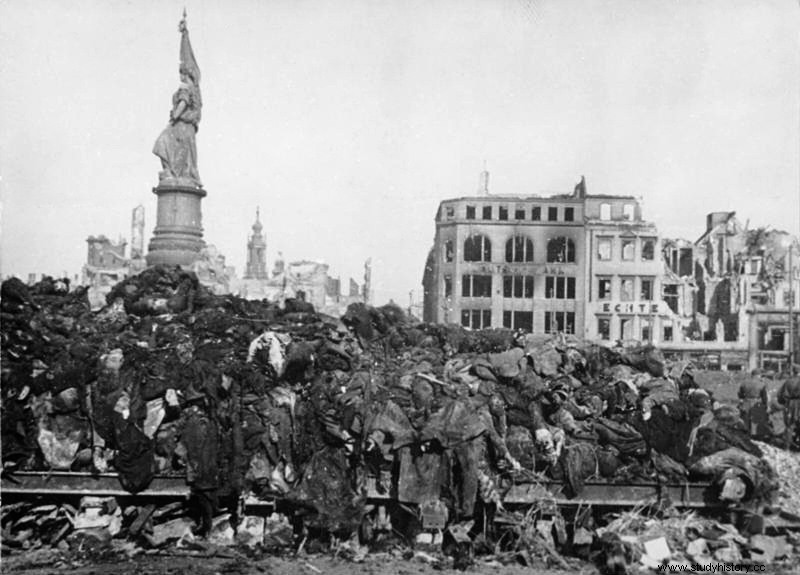
Many stone buildings, cobblestone streets or steel-framed buildings also burned. Today there is debate about the use of phosphorus bombs, which would be the only ones that would have allowed these buildings to burn. The British air force denies it, but the investigations seem to show that the reality was different. What is demonstrated is the use of a primitive napalm. British bombers dropped canisters of soft phosphorus mixed with rubber and gasoline. This mixture would burn easily as well as impregnate any surface.
On the morning of the 14th it seems that the worst is over. However, more than 300 B-17 bombers from the United States are heading towards Dresden in a third wave. Your mission is to finish the job by destroying anything left standing. On this occasion, 475 tons of explosive bombs and 396 tons of incendiary bombs fell.
During that third attack, hundreds of people took refuge on the banks of the Elbe River. Many of those present say that several planes made low veil passes machine-gunning the population. In the official documents of the US Air Force there is no record of this. The pilots of the escort fighters also deny the fact.
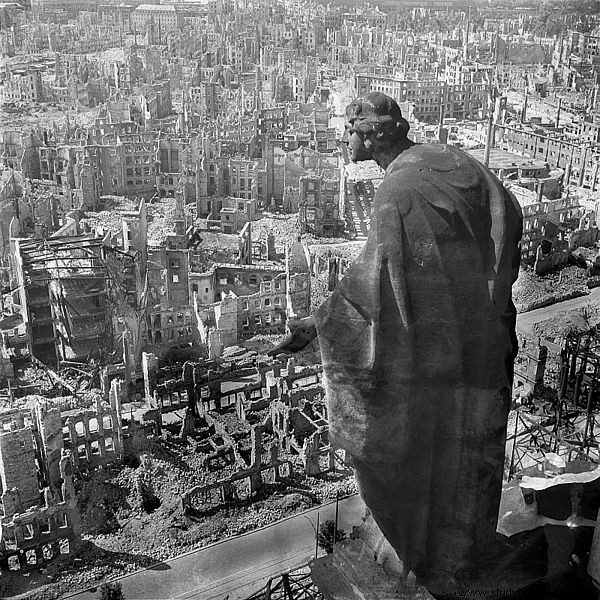
Even today the number of victims of the bombing of Dresden is unknown. The great destruction and the rapid burning of the corpses to prevent epidemics make this task difficult. In addition, the city was populated by tens of thousands of refugees, of whom there is no clear record. The official figure is around 35,000 victims. Other investigations put the figure at up to 300,000.
